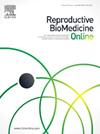经低强度脉冲超声处理的月经血间充质干细胞可通过抑制PI3K/AKT通路修复子宫内膜损伤。
IF 3.7
2区 医学
Q1 OBSTETRICS & GYNECOLOGY
引用次数: 0
摘要
研究问题:低强度脉冲超声(LIPUS)处理经血间充质干细胞(MenSC)对宫内粘连(IUA)的影响和潜在机制是什么?设计:首先,确定MenSC并暴露于LIPUS。研究了lipus处理的MenSC的增殖、迁移、侵袭、细胞因子分泌和向人子宫内膜上皮细胞(HEEC)分化的能力。体外,用10 ng/ml转化生长因子-β1 (TGF-β1)处理人子宫内膜基质细胞(HESC)模拟IUA,然后与lipus处理的MenSC间接共培养。在体内,构建IUA大鼠模型,将经lipus处理的MenSC移植到子宫内。检测子宫的形态、结构、纤维化水平和修复相关因子。在机制研究中,我们应用胰岛素样生长因子-1 (IGF-1)验证PI3K/AKT通路是否参与lipus处理的MenSC对子宫内膜损伤的修复。结果:在体外,LIPUS通过促进细胞增殖和迁移对MenSC有有益作用;抑制细胞凋亡;并增强表皮生长因子、肝细胞生长因子和血管内皮生长因子的表达。通过降低p-PI3K和p-AKT的浓度,促进MenSC向HEEC的分化,同时降低TGF-β1处理HESC的纤维化水平。然而,使用IGF-1后,这些效果被逆转。在体内,经lipus处理的MenSC移植导致子宫长度、宽度和重量增加。移植细胞还改善了子宫内膜结构的完整性,减少了炎症浸润,增加了子宫内膜厚度和腺体丰度,减少了子宫内膜纤维化。此外,经lipus处理的MenSC移植后,观察到子宫内膜修复相关蛋白和接受性相关标志物的浓度增加。结论:lipus治疗的MenSC通过抑制PI3K/AKT通路修复子宫内膜损伤。本文章由计算机程序翻译,如有差异,请以英文原文为准。
Low-intensity-pulsed-ultrasound-treated menstrual-blood-derived mesenchymal stem cells repair endometrial injury by PI3K/AKT pathway inhibition
Research question
What is the effect and underlying mechanism of low-intensity-pulsed-ultrasound (LIPUS)-treated menstrual-blood-derived mesenchymal stem cells (MenSC) on intrauterine adhesions (IUA)?
Design
First, MenSC were identified and exposed to LIPUS. The proliferation, migration, invasion, cytokine secretion, and ability to differentiate into human endometrial epithelial cells (HEEC) of LIPUS-treated MenSC were characterized. In vitro, human endometrial stromal cells (HESC) were treated with 10 ng/ml transforming growth factor-β1 (TGF-β1) to simulate IUA, and then co-cultured indirectly with LIPUS-treated MenSC. In vivo, IUA rat models were constructed and LIPUS-treated MenSC were transplanted into the uterus. The morphology, structure, and levels of fibrosis and repair-related factors of the uterus were detected. In the mechanism study, insulin-like growth factor-1 (IGF-1) was applied to verify whether the PI3K/AKT pathway participated in the repair of endometrial injury by LIPUS-treated MenSC.
Results
In vitro, LIPUS treatment showed beneficial effects on MenSC by promoting cell proliferation and migration; inhibiting apoptosis; and enhancing the expression of epidermal growth factor, hepatocyte growth factor and vascular endothelial growth factor. It also facilitated the differentiation of MenSC into HEEC while reducing the level of fibrosis in TGF-β1-treated HESC by decreasing the concentrations of p-PI3K and p-AKT. However, these effects were reversed with the use of IGF-1. In vivo, transplantation of LIPUS-treated MenSC resulted in increased uterine length, width and weight. The transplanted cells also improved completeness of the endometrial structure, reduced inflammatory infiltration, increased endometrial thickness and gland abundance, and decreased endometrial fibrosis. Additionally, increased concentations of endometrial-repair-related proteins and receptivity-related markers were observed after transplantation of LIPUS-treated MenSC.
Conclusion
LIPUS-treated MenSC repaired endometrial injury by inhibiting the PI3K/AKT pathway.
求助全文
通过发布文献求助,成功后即可免费获取论文全文。
去求助
来源期刊

Reproductive biomedicine online
医学-妇产科学
CiteScore
7.20
自引率
7.50%
发文量
391
审稿时长
50 days
期刊介绍:
Reproductive BioMedicine Online covers the formation, growth and differentiation of the human embryo. It is intended to bring to public attention new research on biological and clinical research on human reproduction and the human embryo including relevant studies on animals. It is published by a group of scientists and clinicians working in these fields of study. Its audience comprises researchers, clinicians, practitioners, academics and patients.
Context:
The period of human embryonic growth covered is between the formation of the primordial germ cells in the fetus until mid-pregnancy. High quality research on lower animals is included if it helps to clarify the human situation. Studies progressing to birth and later are published if they have a direct bearing on events in the earlier stages of pregnancy.
 求助内容:
求助内容: 应助结果提醒方式:
应助结果提醒方式:


